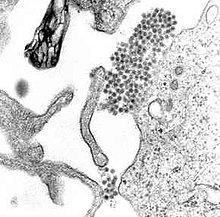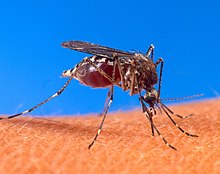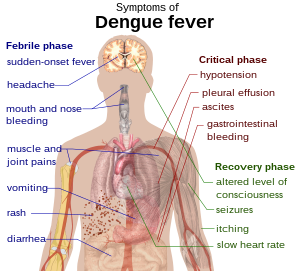
Custom Search
Dengue is transmitted by several species of mosquito within the genus Aedes, principally A. aegypti. The virus has four different types; infection with one type usually gives lifelong immunity to that type, but only short-term immunity to the others. Subsequent infection with a different type increases the risk of severe complications. As there is no vaccine, prevention is sought by reducing the habitat and the number of mosquitoes and limiting exposure to bites.
Treatment of acute dengue is supportive, using either oral or intravenous rehydration for mild or moderate disease, and intravenous fluids and blood transfusion for more severe cases. The incidence of dengue fever has increased dramatically since the 1960s, with around 50–100 million people infected yearly. Early descriptions of the condition date from 1779, and its viral cause and the transmission were elucidated in the early 20th century. Dengue has become a worldwide problem since the Second World War and is endemic in more than 110 countries. Apart from eliminating the mosquitoes, work is ongoing on a vaccine, as well as medication targeted directly at the virus.
Typically, people infected with dengue virus are asymptomatic (80%) or only have mild symptoms such as an uncomplicated fever.[1][2][3] Others have more severe illness (5%), and in a small proportion it is life-threatening.[1][3] The incubation period (time between exposure and onset of symptoms) ranges from 3–14 days, but most often it is 4–7 days.[4] Therefore, travelers returning from endemic areas are unlikely to have dengue if fever or other symptoms start more than 14 days after arriving home.[5] Children often experience symptoms similar to those of the common cold and gastroenteritis (vomiting and diarrhea),[6] but are more susceptible to the severe complications.
Clinical course
The characteristic symptoms of dengue are sudden-onset fever, headache (typically located behind the eyes), muscle and joint pains, and a rash. The alternative name for dengue, "break-bone fever", comes from the associated muscle and joint pains.[1][7] The course of infection is divided into three phases: febrile, critical, and recovery.[8]
The febrile phase involves high fever, often over 40 °C (104 °F), and is associated with generalized pain and a headache; this usually lasts two to seven days.[7][8] At this stage, a rash occurs in approximately 50–80% of those with symptoms.[7][9] It occurs in the first or second day of symptoms as flushed skin, or later in the course of illness (days 4–7), as a measles-like rash.[9][10] Some petechiae (small red spots that do not disappear when the skin is pressed, which are caused by broken capillaries) can appear at this point,[8] as may some mild bleeding from the mucous membranes of the mouth and nose.[5][7] The fever itself is classically biphasic in nature, breaking and then returning for one or two days, although there is wide variation in how often this pattern actually happens.[10][11]

 In some people, the disease proceeds to a critical phase, which follows the resolution of the high fever and typically lasts one to two days.[8] During this phase there may be significant fluid accumulation in the chest and abdominal cavity due to increased capillary permeability and leakage. This leads to depletion of fluid from the circulation and decreased blood supply to vital organs.[8] During this phase, organ dysfunction and severe bleeding, typically from the gastrointestinal tract, may occur.[5][8] Shock (dengue shock syndrome) and hemorrhage (dengue hemorrhagic fever) occur in less than 5% of all cases of dengue,[5] however those who have previously been infected with other serotypes of dengue virus ("secondary infection") are at an increased risk.[5][12]
In some people, the disease proceeds to a critical phase, which follows the resolution of the high fever and typically lasts one to two days.[8] During this phase there may be significant fluid accumulation in the chest and abdominal cavity due to increased capillary permeability and leakage. This leads to depletion of fluid from the circulation and decreased blood supply to vital organs.[8] During this phase, organ dysfunction and severe bleeding, typically from the gastrointestinal tract, may occur.[5][8] Shock (dengue shock syndrome) and hemorrhage (dengue hemorrhagic fever) occur in less than 5% of all cases of dengue,[5] however those who have previously been infected with other serotypes of dengue virus ("secondary infection") are at an increased risk.[5][12]The recovery phase occurs next, with resorption of the leaked fluid into the bloodstream.[8] This usually lasts two to three days.[5] The improvement is often striking, but there may be severe itching and a slow heart rate.[5][8] During this stage, a fluid overload state may occur; if it affects the brain, it may cause a reduced level of consciousness or seizures.







0 comments:
Post a Comment